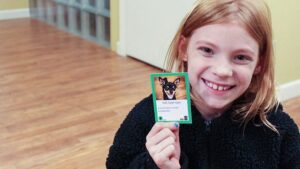Everyone thinks their child won’t be bitten by a dog – until they are. “Fluffy would never…” “Fluffy lets him lay all over her…” I have heard it time after time and it makes me cringe.
According to the CDC, more than half of dog bites to humans occur in the home with a familiar dog. Let’s not let our kids be part of that statistic! Now, I’m certainly not saying to toss Fluffy aside, but rather we need to educate ourselves and our children about safety around dogs.
As a former elementary school teacher and a homeschool mom, I have learned it takes a special recipe for young children to both learn and retain new information. It has to be presented in a way they can understand, it requires repetition, it needs to involve their senses, and humor helps! Lucky for us, there are some wonderful resources available to teach kids about dog bite prevention.
One way to teach your children is to work with a certified dog trainer who offers services for kids and families. On June 22, I will be doing my second kids’ clinic, Learn to Speak Dog, where the children will learn to be dog detectives! Children must – and can be – taught to read canine body language so they know if a dog wants to be approached or not.
We do this in a fun, interactive way by practicing proper interactions with real dogs and engaging both their minds and their bodies, jumping up and down as we yell, “Dogs don’t like hugs and kisses!” (no dogs are in the room for that part!)
We put on dog ear headbands and take turns being a dog, role-playing how to handle real-life situations, like what to do if their dog growls or if a stray dog approaches. Most kids have no idea what to do in situations like that (some adults don’t either) and it’s crucial for their safety that they find out! I also have the kids brainstorm things they shouldn’t do around dogs and reasons why a dog might bite.
Another way to teach kids to stay safe around dogs is to take advantage of the wealth of information on bite prevention websites such as www.doggonesafe.com and www.gooddoginabox.com.
There are cute, animated videos to watch, body language card games to buy, coloring sheets, and great information for parents, too. Most of it is free and available to anyone who’s interested in learning about body language.
For example, did you know that when a dog yawns, licks its lips, or turns its head away from you, these are often signs of stress? Most people can’t read their dog as well as they think they can, and even if your own dog isn’t stressed by your kids, what happens when they visit a friend who has a dog? Will that dog be tolerant of a child he or she doesn’t know? Educating our kids about body language and bite prevention techniques is critical. There are so many wonderful ways to learn and I encourage every parent to take advantage of them.
For information on Rebecca’s bite prevention clinic for kids, go to www.lovethemtrainthem.com.





